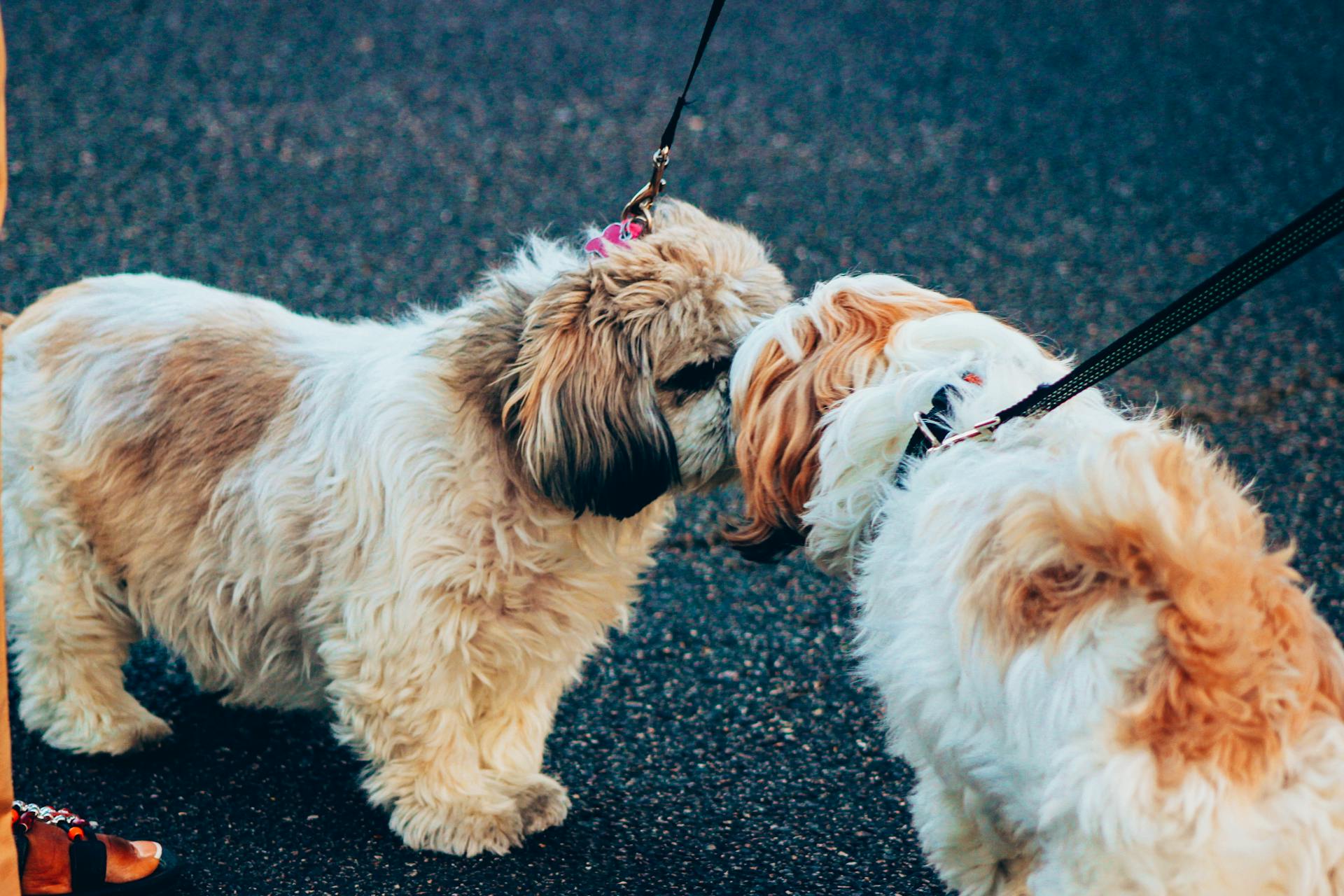
Understanding your dog's body language is crucial to building a strong bond and creating a safe environment for both you and your furry friend. A relaxed dog will often have a loose, open posture with a wagging tail.
A dog's tail can convey a lot of information, with a tucked tail usually indicating fear or anxiety. A tucked tail can also be a sign of submission or stress, especially if it's accompanied by a lowered head and ears.
Dogs will often use their ears to express their emotions, with forward-facing ears indicating confidence and alertness. Ears laid back against the head can suggest fear or submission.
See what others are reading: Dogs Ears Back Tail Wagging
Relaxed and Alert
Dogs can be in a relaxed state, but still be alert and ready to respond to their surroundings. A relaxed dog's ears are often in a neutral position, not necessarily perked up.
A relaxed dog's body posture is often even and distributed evenly between the feet, indicating they feel comfortable and at ease. This "ready" position is a subtle sign that they're prepared to respond if needed.
Curious to learn more? Check out: Why Does Dog Wag Its Tail
Here are some key signs of a relaxed and alert dog:
- Ears: Perked up and pointed forward (look at the base of the ear for floppy-ear breeds)
- Eyes: Wide open and focused with a neutral, relaxed forehead
- Mouth: Closed without tension at the lips or around the snout
- Tail: Extended from the body, even with the spine and possibly wagging slightly
Your Relaxed Approachable
A relaxed and approachable dog is a wonderful thing, and it's essential to recognize the signs. A dog in this state is unconcerned and unthreatened by their surroundings, making them approachable.
They'll often have a loose, waggy posture, which is a great sign of happiness. Their ears will be held in their natural position, whether that's pointed or floppy.
Their eyes will be soft, and their forehead will be neutral, without any wrinkles. This calm expression is a great indicator of a relaxed dog.
A relaxed dog's mouth will be either closed without tension around the lips or open in a relaxed pant, depending on their activity level. And their tail will be wagging in a wide, sweeping motion that's even with their spine.
Here are some key signs to look out for:
By recognizing these signs, you can build a stronger bond with your dog and prevent potential conflicts.
Alert

An alert dog is assessing its surroundings for more information. Their ears are perked up and pointed forward, and their eyes are wide open and focused with a neutral, relaxed forehead.
You can tell if a dog is alert by looking at its body language. A dog that's alert will have its ears up and its eyes focused on something in particular.
A dog that's alert may have detected something of interest or something unknown. It's assessing the situation to determine if there's any threat or if it needs to take action.
Here are some signs that a dog is alert:
- Ears: Perked up and pointed forward (look at the base of the ear for floppy-ear breeds)
- Eyes: Wide open and focused with a neutral, relaxed forehead
- Mouth: Closed without tension at the lips or around the snout
- Tail: Extended from the body, even with the spine and possibly wagging slightly
If a dog is alert, it's best to give it space and let it assess the situation. This will help it feel more secure and in control.
Yawning
Yawning can be a sign of stress in dogs, and it's often accompanied by other nervous behaviors.
If your dog is yawning in the middle of the day, it's likely not because they're tired - they're probably just feeling a bit anxious or worried.

Some dogs may yawn when they're feeling stressed or overwhelmed, and it's a way for them to self-soothe.
Dogs can pick up on their owner's emotions and energy, so if you're feeling stressed, it's possible your dog is too.
If you notice your dog yawning frequently, it may be worth looking into ways to reduce their stress levels, such as providing a calm and predictable environment.
Stressed or Nervous
A stressed or nervous dog will exhibit many of the same postures as a fearful dog, but they might also perform calming signals to self-calm or reduce escalating tension.
These movements include looking away, turning away, moving in a curve, slow movements, yawning, freezing, lip licking, lip smacking, sniffing the ground, raising one paw, scratching, and shaking off like after getting wet.
A stressed dog often avoids eye contact or looks at the trigger, then quickly looks away. They might also perform exaggerated yawns, sneeze, or lick their lips frequently.
Here are some common calming signals to look out for:
- Looking away
- Turning away
- Moving in a curve
- Slow movements
- Yawning
- Freezing
- Lip licking
- Lip smacking
- Sniffing the ground
- Raising one paw
- Scratching
- Shaking off (like after getting wet)
If you notice your dog exhibiting these behaviors, it's essential to provide a calm and safe environment for them to relax.
Aggression and Submission
Dogs use body language to communicate aggression or submission, and it's essential to recognize these signals to prevent conflicts. A dog showing aggressive body language is ready to react to a stressor, with rigid and tense postures, raised fur, and a stiff-legged stance.
Ears, eyes, and mouth are key indicators of aggression. Ears are held differently depending on the reason for the aggression, while eyes are fixed on the stimulus with a hard, unwavering stare. A tense mouth with wrinkles across the muzzle or a raised upper lip exposing the teeth is also a sign of aggression.
Dogs displaying submissive signals are trying to reduce a perceived threat. They may avoid direct eye contact, yawn, or lick their nose, and lower their ears, head, and neck. Submissive postures can progress to low crouching, raising a front paw, lying down, and rolling over to expose the abdomen.
It's essential to recognize that both assertive and submissive body language aim to forestall a potential threat and/or change the outcome of a social encounter.
Raised Hackles
Raised hackles are a key indicator of a dog's emotional state. A dog's hackles rise when they're feeling excited or scared, causing the hair on their back to stick up through a reflex called piloerection.
This reflex is the same one that causes goosebumps in humans when we're feeling nervous or scared. Dogs may exhibit raised hackles in various situations, such as when they're feeling threatened or when they're trying to appear larger.
Raised hackles can be a sign of aggression, but they can also be a sign of fear. For example, a dog that's feeling fearful may tuck its tail between its legs and raise its hackles, indicating that it's trying to keep the perceived threat at a distance.
Here are some common signs of raised hackles in dogs:
- Raised hackles on the shoulders and rump
- Stiffened muscles and tense limbs
- Vertical or arched tail
- Slow and deliberate or rapid and vibrating tail movement (flagging)
Keep in mind that raised hackles don't necessarily mean a dog is aggressive or dominant. It's essential to consider the entire body language of the dog, including its posture, facial expressions, and vocalizations, to understand its emotional state.
My Submissive
My dog displays appeasement or "submissive" signals when he feels threatened or wants to reduce tension. These body postures are a way for him to communicate his desire to avoid confrontation.
A dog's eyes are a significant indicator of his emotional state, and avoiding direct eye contact is a very subtle yet significant gesture. This signals that my dog is putting himself at risk by not visually following a circumstance that could change rapidly.
Yawning and nose-licking are considered ambivalent behaviors, meaning my dog is cautious, concerned, stressed, anxious, or has the potential to respond with aggression if the situation escalates or persists. These postures are often described as "appeasement" behaviors because they communicate a desire for the threat to stop and no desire for confrontation.
Submissive signals can progress to more extreme behaviors, such as low crouching, raising a front paw, lying down, and rolling over to expose the abdomen. This behavior developed from puppyhood when a pup would present to an adult in the group.
If this caught your attention, see: Submissive Peeing Female Dog
Here are some common appeasement dog body language signs:
- Ears: Pinned back
- Eyes: Avoiding eye contact and squinting their eyes
- Mouth: Tension around the mouth, and the dog might pull back their lips to expose their front teeth in an "appeasement grin"
- Tail: Tucked or held low and moving in a slow, tight wag
- Front paw: Raised in an appeasement gesture
It's essential to remember that my dog's submissive posturing is not a sign of weakness or lack of confidence, but rather a way to decrease any perceived threat. By understanding these signs, I can better communicate with my dog and create a more harmonious relationship.
Sources
- https://www.petmd.com/dog/behavior/how-to-read-dog-body-language
- https://be.chewy.com/decoding-dogs-body-language/
- https://vcahospitals.com/know-your-pet/canine-communication---interpreting-dog-language
- https://staroftexasvet.com/deciphering-your-dog-canine-body-language/
- https://moderndogmagazine.com/articles/how-to-read-your-dogs-body-language/
Featured Images: pexels.com


